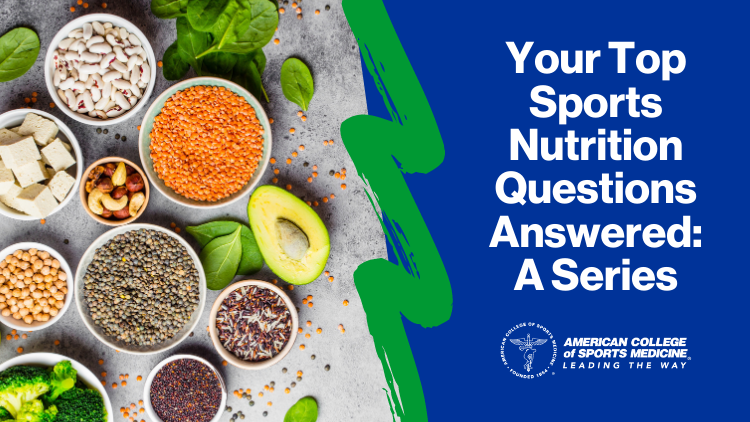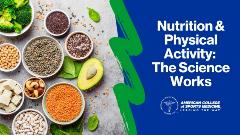Dan Benardot, Ph.D., DHC, R.D., L.D., FACSM |
Dec.
17, 2020

3 Nutrition FAQs from the webinar - Nutrition and Physical Activity: The Science Works
This part of the FAQ series covers: recovery ratios, and intermittent fasting and older adults.
Watch the Webinar on the Professional Resources Page
Not a Member? Join Today!
Q4: I have heard before of a 3g:1g carbs: protein ratio for recovery. You are talking more about a 25g carbs for 20g protein. Why is this ratio better for recovery?
The key point to consider is that there is evidence that both carbohydrate and protein consumption post exercise are important. The general recommendation is that more carbohydrate (g/kg) should be consumed post exercise than protein, but the data on the specific ratio are, as yet, categorized as only ‘fair’ or ‘limited’ (see reference below: Thomas et al., 2016).
It has been summarized from these studies that consuming about 20 to 30 g protein, or ~10g of essential amino acids post-exercise results in increased whole body and muscle protein synthesis as well as improved nitrogen balance. Please note the large range in the recommendation (i.e., 20 to 30 g). It has also been found that co-ingestion of carbohydrate with protein found no significant improvement on muscle glycogen synthesis, as this is primarily a carbohydrate only factor.

Download Sample Now
It has been determined that the highest rate of muscle glycogen synthesis occurs when large amounts of carbohydrate (1.0–1.85 g/kg/h) are consumed
immediately post-exercise and at 15-minute intervals thereafter, for up to 5 hours post-exercise. (Please note the range in carbohydrate recommendation.) The total
daily recommended protein intake is approximately the same (1.2 to 2.0 g/kg/d) as the post-exercise hourly intake of carbohydrate, suggesting that post-exercise carbohydrate needs are significantly higher post exercise.
To put this into relative perspective, the recommendation for 30 g of protein post exercise for a 150 lb (68 kg) athlete represents about 0.44 g/kg protein, with the recommendation for carbohydrate significantly higher. These data also suggest differential effects, with protein consumption focusing primarily on muscle soreness and recovery, with carbohydrate consumption focusing primarily on glycogen recovery.

View Nutrition FAQs on fasting, adaptation timing and glycogen.
Clearly, athletes need carbohydrate, protein, and fluids post exercise, and the judgement on the relative amount provided should be based on the degree to which glycogen depletion and muscle soreness have occurred, which are factors likely related to exercise duration and intensity, and fluid volume/quality consumed during exercise.
As a side note, since energy balance is likely to be low post exercise, a relatively high protein and low carbohydrate intake post-exercise is likely to result in at least a portion of the protein being used to satisfy energy recovery needs. As this can only occur when protein is denitrogenated, the resultant higher blood urea nitrogen is likely to result in higher urine production and inhibit a speedier return to a well-hydrated state.
- Thomas DT, Erdman KA, Burke LM. American College of Sports Medicine Joint Position Statement: nutrition and athletic performance. Med Sci Sports Exerc. 2016;48(3):543–68.
Q5: You mentioned skipping meals increases risk for cardiometabolic diseases. What about intermittent fasting protocols?
This is an important issue, so I appreciate your question. In the references provided below, it was found that subjects who skipped breakfast as adults had significantly higher WC and BMI, and that subjects who skipped breakfast as children and as adults had even higher WC and BMI, and more cardiometabolic risk factors. (Smith et al., American Journal of Clinical Nutrition. 2010.; Isacco et al., Child Care Health and Development. 2010.)
The result of intermittent fasting that you describe is to create a state of relative energy deficiency, so it is important for you to carefully review the International Olympic Committee consensus statements on the health and performance issues created with Relative Energy Deficiency in Sport (RED-S). These references, as IOC consensus statements, are publicly available (suggest doing a Google Scholar search for ‘Mountjoy RED-S’) to download and review. Here are some references related to RED-S:
Mountjoy M, Sundgot-Borgen JK, Burke LM, et al. IOC Consensus Statement on Relative Energy Deficiency in Sport (RED-S) Br J Sports Med. doi:10.1136/ bjsports-2018-099193
Torstveit MK, Fahrenholtz I, Stenqvist TB, Sylta O, and Melin A. Within-Day Energy Deficiency and Metabolic Perturbation in Male Endurance Athletes. Int J Sport Nutr Exerc Metab. 2018; 28: 419-427
Fahrenholtz IL, Sjödin A, Benardot D, et al. Within-Day Energy Deficiency and Reproductive Function in Female Endurance Athletes. Scand J Med Sci Sports 2018; 1-8: DOI: 10.111/sms.13030.
Delk-Licata A, Behrens CE, Benardot D, et al. The Association Between Dietary Protein Intake Frequency, Amount, and State of Energy Balance on Body Composition in a Women’s Collegiate Soccer Team. Int J Sports Exerc Med 2019; 5(3):123. DOI:https://doi.org/10.23937/2469-5718/1510123
These papers and the book (ACSM’s Nutrition for Exercise Science) clearly describe the health and performance issues created when there is insufficient energy available to perform the physical task at hand. While there may be a temporary ‘weight’ loss, the elevation in cortisol suggests that far too much of the weight is coming from lean tissue, which compromises the very tissue the athlete is trying to improve through exercise.
In addition, cortisol is highly catabolic to bone tissue, placing the athlete at higher risk of skeletal injury (stress fracture, etc.). It is important to consider that blood sugar maintenance during the day with normal daytime activity is approximately 3 hours, and at night while asleep approximately 7 hours. Exercising when in a low blood sugar state, as these papers clearly describe, creates precisely the opposite outcomes to what the athlete is wishing to achieve.
Thank you for asking this important question.
Q6: I'm glad we're talking about sex-related differences in youth. But what about sex-related difference in adulthood? And what about sex-related changes as we reach older-adults? Particularly when it comes to menopause? The research in these areas are limited but we need to start having these conversations more and recognize that these do require different things.
Thank you for your question. I couldn’t agree with you more that this is a critically important area, and that we have much more to learn. Recent studies indicating that older people can increase lean tissue just as quickly as younger people, but that they can lose lean/skeletal tissue much more quickly than younger people absent appropriate physical activity and nutritional strategies has huge implications for matching appropriate nutrition and physical activity strategies.
There are also issues related to sustaining a reasonable energy balance through a dynamic matching of energy intake and expenditure. While the health and performance sequellae of Relative Energy Deficiency in Sport (RED-S) have been reviewed for competitive athletes, there is scant information for how RED-S may differentially impact older active individuals of different sexes. Chapter 10 of “ACSM’s Nutrition for Exercise Science” is devoted to reviewing what we know about optimizing nutrition strategies for different ages and sex. The focus on older athletes are the following health-related issues:
- Age-related changes in body composition and the impact this has on REE;
- Lowered capacity to quickly recover from intensive or long bouts of exercise;
- Gradually diminishing bone mass;
- Subtle changes in GI tract function that could influence nutrient absorption;
- Progressively lower heat tolerance;
- Progressive decreases in the glomerular filtration rate and renal blood flow;
- Reduced capacity to concentrating urine, increasing urinary frequency, and, potentially, lowering fluid consumption.
I appreciate you bringing this to my attention. Be assured that future talks I give will give appropriate attention to this important issue.
Explore More Popular Nutrition Content

Nutrient Timing Strategy for Protein and More | Video

Nutrition Spotlight | CEC Bundle
Presenter:
ACSM Fellow Dan Benardot, Ph.D., DHC, R.D., L.D., is Professor Emeritus at Georgia State University, and Professor of Practice in the Center for the Study of Human Health at Emory University. He is the author of the popular book ACSM’s Nutrition for Exercise Science.